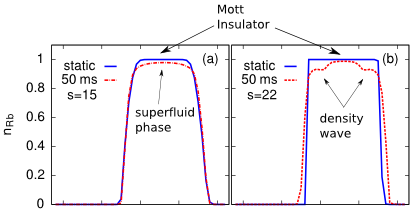Dynamics in ultracold gases
Ultra cold gases in optical lattices provide a powerful system for experimental investigations of interacting quantum many body systems. Due to tunable intra- and interspecies interactions, degenerate quantum gases give insight into strongly and weakly correlated regimes and possible phase transitions. By increasing the depth of the optical lattice where i.e. a Bose-Einstein condensate is loaded, one induces the Superfluid-Mott Insulator transition [1]. These and other experiments [2,3] are investigating the low-temperature properties. However, ramping up the optical lattice can easily increase the temperature or excite higher bands [2] and pose one of the fundamental limitations faced by current experiments. Consequently a theoretical analysis of those effects is important.
The timescale for ramping the optical lattice in the experiment is usually determined such that the system ends up in the lowest band of the optical lattice, i.e. the ramping time is chosen large with respect to the band gap. However, this does not guarantee that the ramp is also adiabatic with respect to the many-body states in the lowest band. The arising questions are: i) what is the thermalisation/relaxation time, ii) under which conditions is the ramping up of the optical lattice sufficiently slow, such that the ramp-up process is adiabatic, iii) what are the typical timescales for dynamically induced processes.
Some of that issues have been investigated by methods as t-DMRG, also known as TEBD [4], which however is tailored to 1D systems, and mean field techniques [5,6,7]. As the latter is applicable to higher dimensions it is more suitable for descussions of recent experiments [8]. The Gutzwiller mean-field method (similar as Hartree-Fock) can straightforwardly be generalized to time-dependent calculations. At zero temperature, the total wave function is assumed to be a product wave function over the lattice sites
|
|
Each of the on-site wave-functions is evolved in time according to the local Schrödinger equation
|
|
Depending on the ramping velocity different effect can occure. Ramping the lattice to higher lattice depth with the same ramp-up time means effectively faster increase of the lattice depth per time unit. This causes not only significant deviations from the static density profiles but also the formation of density waves
|
|
Additionally dynamics can lead to decreased visbility which is related to the coherence grade of the many body wave function. In static or adiabatic case the decrease of the visibility can be related to the transition of the superfluid to Mott-Insulating phase [Bloch]. In nonadiabatic systems, as can be simulated dynamically, the phasecoherence can be lost although the particles still have superfluid properties.
 |
 |
Moreover collective effects can be observed. Due to harmonic confining potential the oscillations of the entire superfluid atoms, i.e. the breathing mode, can be excited. Depending on the coupling strength to such modes, the phase coherence (and so the visibility) of the system can increase or decrease. This makes the search of the most adiabatic ramping time by analyzing only the visbility, as has been done until know, less appropriate.
[1] M. Greiner, O. Mandel, T. Esslinger, T. W. Hänsch, and I. Bloch, Nature 415 (2002).
[2] Sebastian Will, Thorsten Best, Ulrich Schneider, Lucia Hackermüller, Dirk-Sören Lühmann, and Immanuel Bloch, arXiv:0911.5066
[3] Lucia Hackermuller, Ulrich Schneider, Maria Moreno-Cardoner, Takuya Kitagawa, Sebastian Will, Thorsten Best, Eugene Demler, Ehud Altman, Immanuel Bloch and Belen Paredes, arXiv:0910.3598
[4] J. Zakrzewski and D. Delande, arXiv:0902.1117v1 (2009)
[5] J. Wernsdorfer, M. Snoek, and W. Hofstetter, arXiv:0911.0697v1 (2009)
[6] J. Zakrzewski, Phys. Rev. A 71, 043601 (2005).
[7] P. Buonsante, S. M. Giampaolo, F. Illuminati, V. Penna, and A. Vezzani, Phys. Rev. Lett. 100, 240402 (2008).
[8] J. Catani, L. D. Sarlo, G. Barontini, F. Minardi, and M. Inguscio, Phys. Rev. A 77 (2008).








